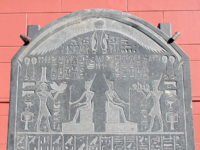
Lunette (stele)
Encyclopedia

Stele
A stele , also stela , is a stone or wooden slab, generally taller than it is wide, erected for funerals or commemorative purposes, most usually decorated with the names and titles of the deceased or living — inscribed, carved in relief , or painted onto the slab...
s as a prelude to a stele's topic. Its major use was from ancient Egypt in all the various categories of steles: funerary, Victory Steles, autobiographical, temple, votive, etc.
The lunettes are most common from ancient Egypt
Ancient Egypt
Ancient Egypt was an ancient civilization of Northeastern Africa, concentrated along the lower reaches of the Nile River in what is now the modern country of Egypt. Egyptian civilization coalesced around 3150 BC with the political unification of Upper and Lower Egypt under the first pharaoh...
ian steles, as not only is the topic of the stele presented, but honorific gods, presenters, individuals, etc are previewed, and often with Egyptian hieroglyphic
Egyptian hieroglyphs
Egyptian hieroglyphs were a formal writing system used by the ancient Egyptians that combined logographic and alphabetic elements. Egyptians used cursive hieroglyphs for religious literature on papyrus and wood...
statements.
The main body of the stele is then presented below, often separated with a horizontal line (register
Register (sculpture)
In art and archaeology, a register is a vertical level in a work that consists of several levels, especially where the levels are clearly separated by lines; modern comic books typically use similar conventions...
), but not always. In Egyptian steles, many have horizontal lines of hieroglyphs; often the lunette will contain shorter vertical statements in hieroglyphs, sometimes just names of the individuals portrayed, hieroglyphs in front, or behind the individual.
19th Dynasty Egypt, post Amarna
From the post-AmarnaAmarna
Amarna is an extensive Egyptian archaeological site that represents the remains of the capital city newly–established and built by the Pharaoh Akhenaten of the late Eighteenth Dynasty , and abandoned shortly afterwards...
period onwards, many personal stelas made exhortations to the gods. Stelas to specific gods: "were erected to intervene personally with the local god, often to seek justice or offer an explanation for things that had gone wrong in their lives. The deceased is shown kneeling
Man-seated: arms in adoration (hieroglyph)
The ancient Egyptian Man-seated: arms in adoration hieroglyph is one of a series of language and visual hieroglyphs used from the earliest dynasties of Ancient Egypt, and that portrays men, women, ideology, and some occupations....
, holding up his hands
Man-seated: arms in adoration (hieroglyph)
The ancient Egyptian Man-seated: arms in adoration hieroglyph is one of a series of language and visual hieroglyphs used from the earliest dynasties of Ancient Egypt, and that portrays men, women, ideology, and some occupations....
in prayer, ....." Some of the personal votive stelas had ears (hieroglyphs), to represent the gods listening to the supplicant.

